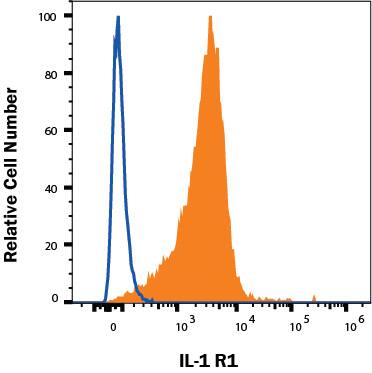Mouse IL-1 RI Antibody
R&D Systems, part of Bio-Techne | Catalog # MAB7712


Conjugate
Catalog #
Key Product Details
Species Reactivity
Validated:
Mouse
Cited:
Mouse
Applications
Validated:
CyTOF-ready, Flow Cytometry, Western Blot
Cited:
Flow Cytometry
Label
Unconjugated
Antibody Source
Monoclonal Rat IgG2B Clone # 129304
Product Specifications
Immunogen
Mouse myeloma cell line NS0-derived recombinant mouse IL-1 RI
Leu20-Lys338
Accession # P13504
Leu20-Lys338
Accession # P13504
Specificity
Detects mouse IL-1 R1 in direct ELISAs and Western blots.
Clonality
Monoclonal
Host
Rat
Isotype
IgG2B
Scientific Data Images for Mouse IL-1 RI Antibody
Detection of IL-1 RI in RAW264 cells by Flow Cytometry.
RAW264 cells were stained with Rat Anti-Mouse IL-1 RI Monoclonal Antibody (Catalog # MAB7712, filled histogram) or isotype control antibody (Catalog # MAB0061, open histogram), followed by Phycoerythrin-conjugated Anti-Rat IgG Secondary Antibody (Catalog # F0105B). View our protocol for Staining Membrane-associated Proteins.Applications for Mouse IL-1 RI Antibody
Application
Recommended Usage
CyTOF-ready
Ready to be labeled using established conjugation methods. No BSA or other carrier proteins that could interfere with conjugation.
Flow Cytometry
0.25 µg/106 cells
Sample: RAW264 cells
Sample: RAW264 cells
Western Blot
1 µg/mL
Sample: Recombinant Mouse IL-1 RI Fc Chimera (Catalog # 771-MR)
Sample: Recombinant Mouse IL-1 RI Fc Chimera (Catalog # 771-MR)
Formulation, Preparation, and Storage
Purification
Protein A or G purified from hybridoma culture supernatant
Reconstitution
Reconstitute at 0.5 mg/mL in sterile PBS. For liquid material, refer to CoA for concentration.
Formulation
Lyophilized from a 0.2 μm filtered solution in PBS with Trehalose. *Small pack size (SP) is supplied either lyophilized or as a 0.2 µm filtered solution in PBS.
Shipping
Lyophilized product is shipped at ambient temperature. Liquid small pack size (-SP) is shipped with polar packs. Upon receipt, store immediately at the temperature recommended below.
Stability & Storage
Use a manual defrost freezer and avoid repeated freeze-thaw cycles.
- 12 months from date of receipt, -20 to -70 °C as supplied.
- 1 month, 2 to 8 °C under sterile conditions after reconstitution.
- 6 months, -20 to -70 °C under sterile conditions after reconstitution.
Background: IL-1 RI
Long Name
Interleukin 1 Receptor I
Alternate Names
CD121a, IL-1RI, IL1R1, IL1RI
Gene Symbol
IL1R1
UniProt
Additional IL-1 RI Products
Product Documents for Mouse IL-1 RI Antibody
Product Specific Notices for Mouse IL-1 RI Antibody
For research use only
